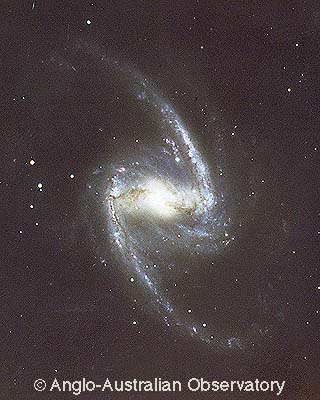Barred Galaxies
| So spiral arms are a rotating
density wave, where
the self-gravity of the disk help
to
"amplify" the spiral features.
How big of an amplification can we get? In
some cases,
the amplification can be very strong
and we can get barred galaxies.
Approximately 1/3 of spiral galaxies are
barred -- bars
are common, but not universal.
-
What makes a galaxy barred?
-
How long do they last?
|
 |
Numerical simulations of galaxies have shown that,
by
themselves, rotating disks are wildly unstable,
and will spontaneously form bars. Why?
Take a disk where all the stars are
rotating
on perfectly circular orbits - relative to one another, the stars
aren't
moving. Tweak it just a little, so that there is a little bit of excess
density somewhere in the disk. Nearby stars will begin to fall towards
this density excess, making it even more excessive. So stars further
away
will begin to feel the pull, and they will fall in. And we keep going
until
everyone is falling towards the excess, and we have a bar.
Like this: MPEG
movie showing
a bare disk going bar unstable.
At this point, stars are no longer moving on circular
orbits, they are moving on highly elongated orbits along the bar -- we
say they are "trapped" in the bar.
So how do you prevent this from happening? You reduce
the self-gravity of the disk, so that stars don't get trapped. And you
do this by having less mass in the disk and more mass in the dark
matter halo. Since the halo isn't a rotating disk, it doesn't change in
response to the formation of a bar, and so the overall density
perturbation is much weaker. Stars no longer get trapped in a bar. So
the disk:halo mass ratio is one important factor in determining if a
galaxy is unstable to forming a bar.
In fact, we can use this as a constraint
on dark matter. If disk galaxies didn't have dark matter
halos,
they'd be very unstable against bar formation, and all spirals should
be
very strongly barred. This
is known as the Ostriker-Peebles criterion.
Here's an MPEG movie of
that
same galaxy, this time with a massive dark halo around it.
But for barred galaxies, once stars are trapped in
the bar, it is very hard to get them out of the bar. So are bars
permanent features of galaxies? Can bars be disrupted and destroyed?
Bar destruction
Once a strong bar forms, the stars are no longer
orbiting
on circular orbits -- the bar has twisted the orbits so that the stars
are moving on more radial orbits, passing close though the center of
the
galaxy. In fact, it is the stars on radial
orbits which make up the bar.
To destroy the bar, we want to move the stars off
radial
orbits. How would we do this? Hint:
think about what happens when a star moves through the center of the
galaxy,
and what it might meet.
Here's an example of bar
dissolution
in action (from Norman, Sellwood,
and
Hasan 1996):

Galaxy Evolution
Here's the rub: Strong
bars
can drive interstellar gas inwards, towards the center of
the
galaxy. Why? Gas dissipates energy during collisional shocks, and can
flow
inwards. Stars don't collide, so they don't dissipate energy, so
there's
no net infall of stars.
So put these three pieces of information together:
-
Bars form from self-gravity of the disk.
-
Strong bars drive gas inwards.
-
Central mass concentrations destroy bars.
Can we come up with an consistant evolutionary scenario
for
barred galaxies and normal galaxies?

